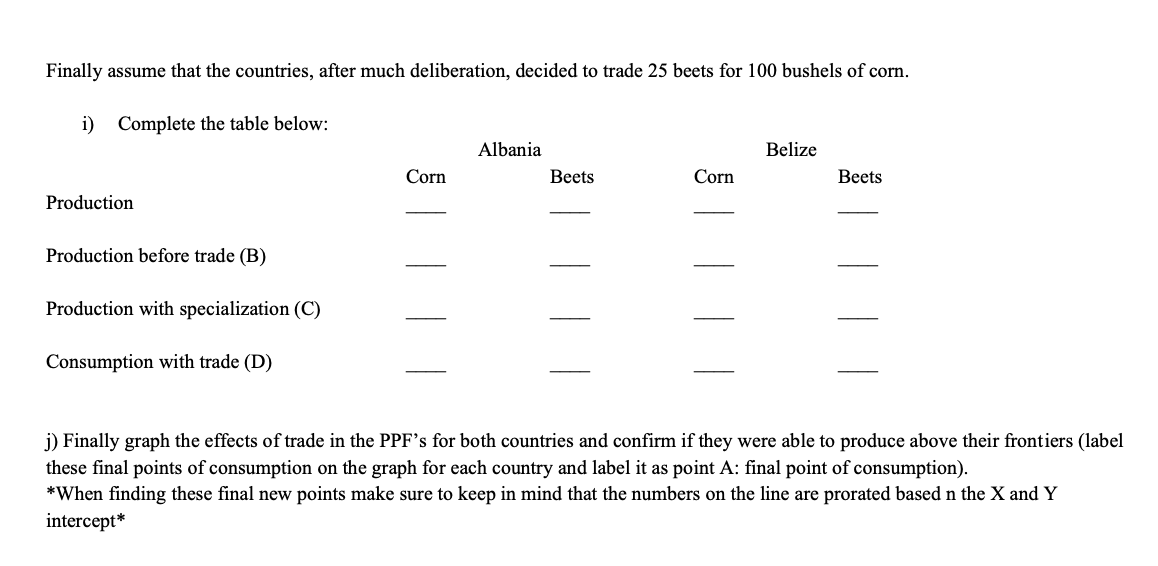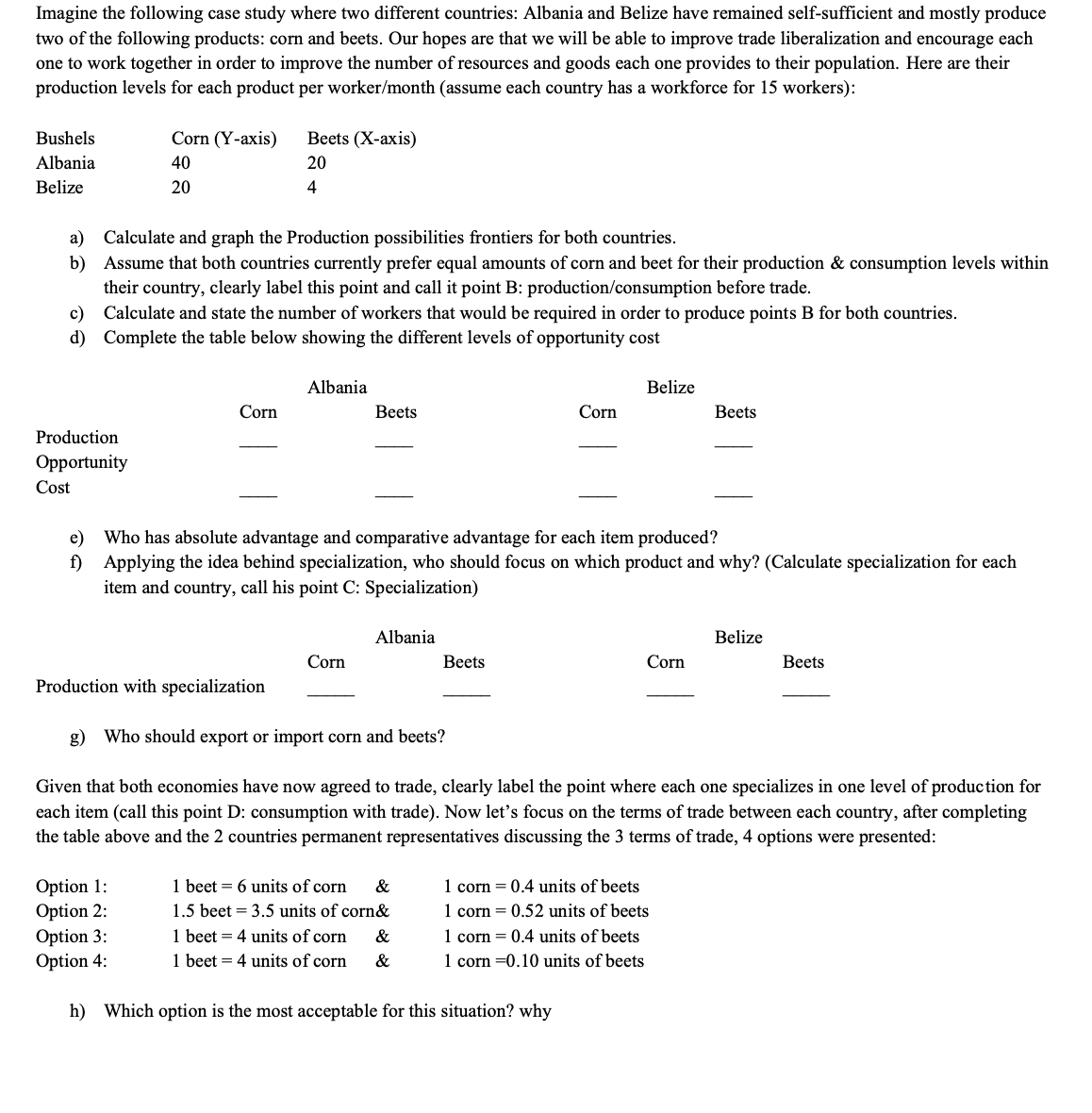Ily assume that the countries, after much deliberation, decided to trade 25 beets for 100 bushels of corn. i) Complete the table below: Albania Belize Corn Вeets Corn Beets luction luction before trade (B) luction with specialization (C) sumption with trade (D) nally graph the effects of trade in the PPF's for both countries and confirm if they were able to produce above their frontiers (label e final points of consumption on the graph for each country and label it as point A: final point of consumption). en finding these final new points make sure to keep in mind that the numbers on the line are prorated based n the X and Y серt*
Ily assume that the countries, after much deliberation, decided to trade 25 beets for 100 bushels of corn. i) Complete the table below: Albania Belize Corn Вeets Corn Beets luction luction before trade (B) luction with specialization (C) sumption with trade (D) nally graph the effects of trade in the PPF's for both countries and confirm if they were able to produce above their frontiers (label e final points of consumption on the graph for each country and label it as point A: final point of consumption). en finding these final new points make sure to keep in mind that the numbers on the line are prorated based n the X and Y серt*
Chapter18: International Trade And Comparative Advantage
Section: Chapter Questions
Problem 2TY
Related questions
Question
Can part I and J be further explained/answered? I've already asked the question and recieved an answer but am unsure if the answer is corret.

Transcribed Image Text:Finally assume that the countries, after much deliberation, decided to trade 25 beets for 100 bushels of corn.
i) Complete the table below:
Albania
Belize
Corn
Вeets
Corn
Вeets
Production
Production before trade (B)
Production with specialization (C)
Consumption with trade (D)
j) Finally graph the effects of trade in the PPF's for both countries and confirm if they were able to produce above their frontiers (label
these final points of consumption on the graph for each country and label it as point A: final point of consumption).
*When finding these final new points make sure to keep in mind that the numbers on the line are prorated based n the X and Y
intercept*

Transcribed Image Text:Imagine the following case study where two different countries: Albania and Belize have remained self-sufficient and mostly produce
two of the following products: corn and beets. Our hopes are that we will be able to improve trade liberalization and encourage each
one to work together in order to improve the number of resources and goods each one provides to their population. Here are their
production levels for each product per worker/month (assume each country has a workforce for 15 workers):
Bushels
Corn (Y-axis)
Вeets (X-аxis)
Albania
40
20
Belize
20
4
a) Calculate and graph the Production possibilities frontiers for both countries.
b) Assume that both countries currently prefer equal amounts of corn and beet for their production & consumption levels within
their country, clearly label this point and call it point B: production/consumption before trade.
c) Calculate and state the number of workers that would be required in order to produce points B for both countries.
d) Complete the table below showing the different levels of opportunity cost
Albania
Belize
Corn
Вets
Corn
Вeets
Production
Opportunity
Cost
e) Who has absolute advantage and comparative advantage for each item produced?
f) Applying the idea behind specialization, who should focus on which product and why? (Calculate specialization for each
item and country, call his point C: Specialization)
Albania
Belize
Corn
Вeets
Corn
Вeets
Production with specialization
g) Who should export or import corn and beets?
Given that both economies have now agreed to trade, clearly label the point where each one specializes in one level of production for
each item (call this point D: consumption with trade). Now let's focus on the terms of trade between each country, after completing
the table above and the 2 countries permanent representatives discussing the 3 terms of trade, 4 options were presented:
Option 1:
Option 2:
Option 3:
Option 4:
1 beet = 6 units of corn
1.5 beet = 3.5 units of corn&
1 beet = 4 units of corn
1 beet = 4 units of corn
1 corn = 0.4 units of beets
1 corn = 0.52 units of beets
1 corn = 0.4 units of beets
1 corn =0.10 units of beets
&
&
&
h) Which option is the most acceptable for this situation? why
Expert Solution
This question has been solved!
Explore an expertly crafted, step-by-step solution for a thorough understanding of key concepts.
Step by step
Solved in 4 steps with 1 images

Knowledge Booster
Learn more about
Need a deep-dive on the concept behind this application? Look no further. Learn more about this topic, economics and related others by exploring similar questions and additional content below.Recommended textbooks for you


Exploring Economics
Economics
ISBN:
9781544336329
Author:
Robert L. Sexton
Publisher:
SAGE Publications, Inc

Principles of Macroeconomics (MindTap Course List)
Economics
ISBN:
9781285165912
Author:
N. Gregory Mankiw
Publisher:
Cengage Learning


Exploring Economics
Economics
ISBN:
9781544336329
Author:
Robert L. Sexton
Publisher:
SAGE Publications, Inc

Principles of Macroeconomics (MindTap Course List)
Economics
ISBN:
9781285165912
Author:
N. Gregory Mankiw
Publisher:
Cengage Learning

Essentials of Economics (MindTap Course List)
Economics
ISBN:
9781337091992
Author:
N. Gregory Mankiw
Publisher:
Cengage Learning

Principles of Economics (MindTap Course List)
Economics
ISBN:
9781305585126
Author:
N. Gregory Mankiw
Publisher:
Cengage Learning

Principles of Microeconomics (MindTap Course List)
Economics
ISBN:
9781305971493
Author:
N. Gregory Mankiw
Publisher:
Cengage Learning